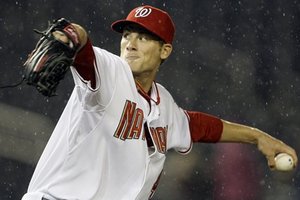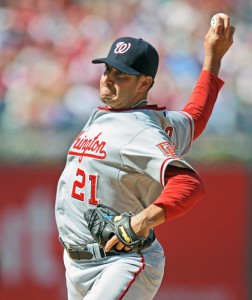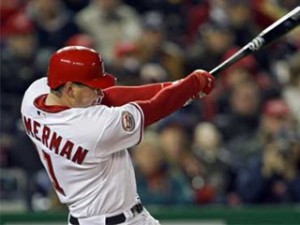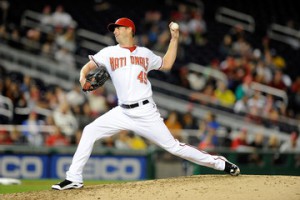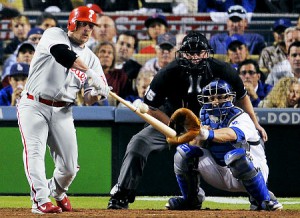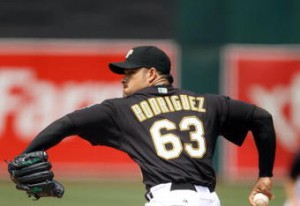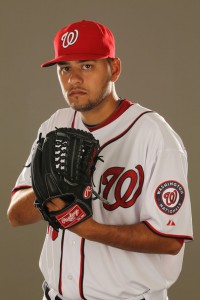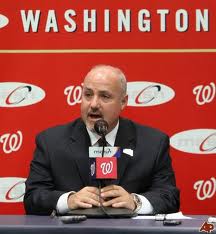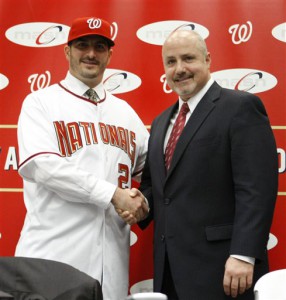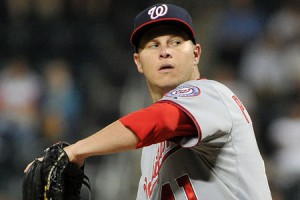
Brad Peacock fires in another fastball during his debut start last night. (Photo by Christopher Pasatieri/Getty Images via sbnation.com)
As a fan of the team, its always neat to see shots of the parents of an up and coming rookie and to listen to the in-game interviews done by Masn’s Debbie Taylor. Collin Balester‘s dad was wearing a big hawaiian shirt and was clearly telling his entire section “that’s my son” while pointing at the field. Craig Stammen‘s parents were a bit more reserved and mentioned their faith while praising their son’s performance. Last night, Brad Peacock‘s dad (a retired cop) was jubilant (if ill-dressed for the occasion) but gave a great mid-inning interview while holding Brad’s son on his lap. That kind of stuff reminds you about something you often forget about when following a team of highly-paid athletes; these guys are people too. They have families, they have priorities, hopes and dreams, and their parents root for them just like your own parents rooted for you when you were a kid. Anyway…
Last night 9/14, Brad Peacock got his first major league start against the Mets, in New York (box/gamer). Though I posted some thoughts on his MLB debut a week ago, it was clearly not the most optimal debut for a rookie starter (brought in with runners on base and pitching from the stretch against an MVP candidate). Last night is a much better indication of what kind of pitcher Peacock may be and what his capabilities are setting up hitters multiple times and working deeper into games.
Game Summary: On the night Peacock’s line was great: 5ip, 0 runs on 2 hits and 3 walks. He had a wild pitch that *maybe* should have been caught by Jesus Flores but which didn’t hurt him.
Early on in the game, Peacock was clearly not getting calls when he missed his spots. He had more than a few calls that were clearly in the “K zone” graphic that MASN uses, but he had missed the target that Flores set up for him. One of the two hits he gave up was to Reyes, who he clearly had struck out but didn’t get the call at the knees. When he did give up harder-hit balls it was usually on pitches that he missed his location. On more than a few occasions he missed out over the plate badly, but the velocity and/or movement on the pitch usually bailed him out, getting popups for foul balls.
After cruising through 3 no-hit innings (only blemish was a 2-out walk to the opposing pitcher), he gave up a decently struck single and then suddenly struggled to find the plate. He had two walks and a wild pitch in the 4th to load the bases before getting a harmless popout. He was more in control in the 5th, getting a nifty play out of Desmond and a one-pitch out from the opposing pitcher before having Reyes struck out (as mentioned before) but giving up the single before retiring Tejada on a liner to Werth.
Velocity: His fastball peaked at 95.1mph early, then he seemed to settle into a pattern of low-90s heat. On the night he averaged 92.77mph on the 4-seamer. This average MPH was a bit lower than during his MLB debut last week (pitch f/x for his debut here, where he averaged 94.15 and peaked at 95.8) and the commentators noted that Peacock’s velocity will average lower in starts than in relief efforts. I’m not sure I believe that necessarily. This team’s approach with its harder throwing starters has clearly been pitching to contact and working deeper into games at the expense of a couple MPH and a few strikeouts. Was that what we saw last night? Or was Peacock just tired from the adrenaline rush of his first start? Or was an average of 94 versus 92 what we should expect during starts? Everything we’ve heard from his stellar minor league season mentions a 95mph fastball, and you would have to think that implies a 95 average, not one 95mph heater every now and again while sitting consistently 92. Yes, relievers can generally throw harder, since they go max-effort for an inning as opposed to having to protect their arm for 100 pitches over 6 innings, but it would be nice to know what to expect out of a starter.
Whatever the speed is on his fastball, the delta between it and his change-up is fantastic. He threw a ton of change-ups (21 out of 94 pitches) and relied on it heavily. His curve more often than not either bounced or started outside and kept on moving outside. I’m not sure I ever saw an inside curve-ball attempt.
Pitch Counts: Through 5 complete innings he was sitting at 94 pitches, needing 31 just to get through the fourth, and clearly his night was over. 94 pitches on the night, 61 for strikes for a pretty good strike/ball ratio. However, 94 pitches to complete 5 innings is rather inefficient, especially for someone who only got two Ks on the night. Lots of these strikes were foul balls, raising his pitch count and driving him from the game early. He will need to find a way to avoid 30-pitch innings and 10-pitch at bats, and will need to work on getting through 6 or 7 innings on that same number of pitches.
GO/AO Ratios: More concerning was the very high ratio of air-outs versus ground-ball outs. Of the 15 outs he recorded:
- 9 were fly balls or line drives to the outfield
- 2 were pop-ups caught in foul territory
- 2 were groundballs
- 2 were strikeouts.
(side note/complaint: the official box score lists ground-outs/fly-outs ratio as 2/6. How do they possibly arrive at this ratio? 11 of his 15 outs were recorded via balls caught before they hit the ground, whether they were fly balls or pop ups. I assume they don’t count foul-ball pop ups as “fly ball outs,” but do they not count the 3 fly-ball outs recorded that were more “line drive” than fly out? At least they got the 2 ground-ball outs correctly tabulated).
That’s an air-out to ground-out ratio of 11/2. That’s downright scary. Conventional wisdom will tell you that a standard number of fly-ball outs turn into home-runs for normal pitchers, and “fly ball” pitchers therefore get tagged with a number of additional runs over their ground-ball pitcher compatriots. This is one of the tenants of the xFIP stat (trying to adjust for “expected” FIP versus actual FIP by standardizing for typical fly-ball to home-run ratios) and sure enough Peacock’s Xfip sits at a monstrous 6.25 right now despite an ERA of 1.42. Of course, we are talking about small sample sizes, and we’d need more information to really draw any conclusions going forward.
Repertoire: Peacock again showed that right now he’s a 2 and a half pitch hurler (here’s pitch f/x data on the night). He featured a four-seam fastball that he relied on heavily, throwing it nearly 2/3s of the time, moving it inside and outside against hitters. He has a pretty good change up that features a 10-mph difference from the fastball and that he commands pretty well and isn’t afraid to throw at any count. And he has a big overhand “knuckle-curve” that features pretty true 12-6 movement but which he doesn’t command nearly as well (he threw 13 last night, only 5 for strikes, but one was an absolute beauty to Satin to get one of his two K’s on the night).
As has been noted by other scouting reports I’ve read, Peacock really needs to work on his curve and develop a 4th pitch if he wants to be a successful MLB pitcher. I don’t perceive his 4-seamer to have enough movement to rely upon (think of Roy Halladay or Greg Maddux, both of whom had such great natural movement on their fastballs that they didn’t really “need” to develop their secondary pitches), and he clearly needs to work on his curve-ball command. The over-hand throwing motion kind of precludes him from considering a cutter (perhaps) or from adding a slider to his arsenal. He probably doesn’t use a 2-seamer because he’s not getting much movement on his 4-seamer now. The overhand motion does lend it self to a couple of pitches he could try: a split-fingered fastball could come in a few mph slower than his current fastball but should exhibit sinking behavior similar to a 2-seam fastball. Or a forkball could be a good pitch that tumbles and drops but which could be thrown a bit harder than a straight change.
Summary: I think he had a nice outing but had some clear areas of concern. I am not sure he can stick as a MLB starter based on what i’m seeing, but could easily be a later innings relief guy (think Joel Hanrahan, and his conversion from 5-inning high ERA starter to effective closer).
